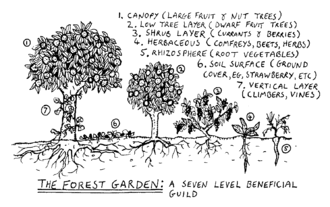We have a few threads on permaculture here, it’s an absolutely fascinating philosophy that I strongly feel is the best possible way to a sustainable future. I will refer you to
those threads and google for more information on what the philosophy of permaculture is all about. I want specifically to focus on one of the techniques of permaculture known as forest gardening or commonly called food foresting. In a nutshell it’s mimicking the design of nature and growing your own custom forest eco-system.
The basic idea behind forest gardening is that a forest is made up of layers and it’s the interaction between and diversity within these layers that creates a healthy living ecosystem. Typically it is viewed as a system of seven layers. I’ll allow Wikipedia to explain:
Wikipedia wrote: Seven-layer system
Seven-layer systemRobert Hart pioneered a system based on the observation that the natural forest can be divided into distinct levels. He used intercropping to develop an existing small orchard of apples and pears into an edible polyculture landscape consisting of the following layers:
1. ‘Canopy layer’ consisting of the original mature fruit trees.
2. ‘Low-tree layer’ of smaller nut and fruit trees on dwarfing root stocks.
3. ‘Shrub layer’ of fruit bushes such as currants and berries.
4. ‘Herbaceous layer’ of perennial vegetables and herbs.
5. ‘Ground cover layer’ of edible plants that spread horizontally.
6. ‘Rhizosphere’ or ‘underground’ dimension of plants grown for their roots and tubers.
7. ‘Vertical layer’ of vines and climbers.
A key component of the seven-layer system was the plants he selected. Most of the traditional vegetable crops grown today, such as carrots, are sun loving plants not well selected for the more shady forest garden system. Hart favoured shade tolerant perennial vegetables.
https://en.wikipedia.org/wiki/Forest_gardening What Wikipedia doesn’t explain is that usually these “productive plants” are intermixed with nitrogen fixing plants that are allowed to die off or cut back and dropped on the ground to decay and feed the productive crops. What is particularly interesting about these unproductive nitrogen fixers for us Nexians is that they just happen to be all the plants that we are particularly interested in.
Let’s take this step by step and try to create an image of how this all comes together and what it looks like when it’s fully up and running.
So to start with we need some land, it doesn’t really matter where the land is we can create a forest anywhere outside the arctic, obviously a (sub)tropical environment offers more diverse options than temperate and desert climates but that’s the beauty of this technique, you can literally
Green the Desert!I will skip the whole process of designing an entire self-managing system that is permaculture and get straight to the food forest creation. The very first step is of course to start building the soil.
On top of the soil layer we need some groundcover, a crop that fixes nitrogen and will help feed the soil with organic matter. This will get the soil in shape for us to start planting. Some particular species of interest to us that happen to serve this purpose are the Delosperma sp. and some of the Desmodium sp. many of which are listed in the literature as containing tryptamines.
Once we have a nice groundcover layer we can chop it down and drop it on the ground to decay and turn into soil. Then we can start planting the forest out from the top down.
So we will start with our canopy trees, these are gonna be the large fruit and nut trees. They should be planted relatively sparsely with lots of space in between; they will be about 10% of the system at this point.
In between the canopy trees we will plant the lower-tree layer trees. About 10% of these will be sparsely scattered dwarf fruit and nut trees that can survive in the shade of the canopy. The other 90% are going to be nitrogen fixing legume type trees. This is particularly good for us because these are our Mimosa sp. Acacia sp. Anadenanthera sp. Vilca sp. Mucuna sp. and so on; basically all the really interesting tryptamine and beta-carboline containing species.
In between the lower-tree layer trees we plant the bushes and shrubs. Again about 10% of these are going to be productive things like berries and herbs. The other 90% are again the nitrogen fixing legumes, here you have things like Elaeagnus sp., some Delosperma sp., Desmanthus sp., Petalostylis sp, etc. basically more interesting tryptamine and beta-carboline containing species. You would also put your Psychotria sp. and Diplopterys sp. Tabernaemontana sp. etc... here.
The herbaceous layer is where we grow our herbs and vegetables; this includes teas, medicines, and smoking/changa herbs. This is also local wildflowers and insect attractors. You could include your clumping grasses such as Phalaris, Phragmites, Digitaria, and Lespedeza here as well.
We already talked about some groundcovers. In the later stages you will focus on more perennial and food items such as strawberries, melons, (sweet)potatoes, and squashes.
We also have the Rhizosphere where we have our root veggies and medicinal herbs. This is taro, ginger, garlic, osha, onions and the like. Many people also place the fungi at this level; the nice thing about creating a temperate forest environment like this is it creates perfect conditions for all sorts of mushrooms and other fungi’s which really are the most important part of the forest.
Last but not least we have the climbers. This is our Ipomoea, Passiflora, and Banisteriopsis as well as peas, beans and the like.
Put it all together and you have a thriving ecosystem.
In a matter of a few years with a minimal amount of upkeep, you will have a self-sufficient, permanent, established forest filled with food and medicine.
And that is just winning plain and simple.
